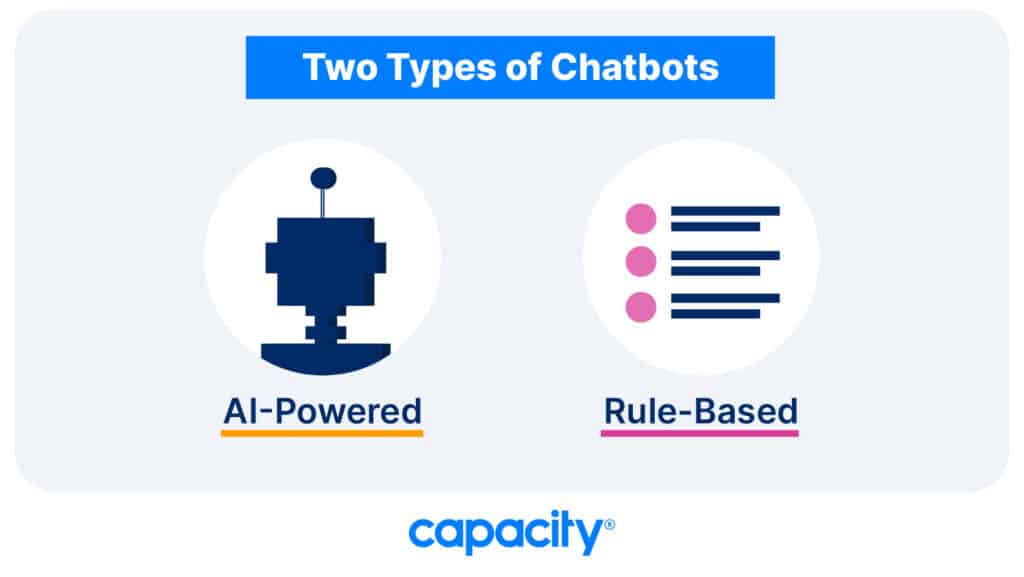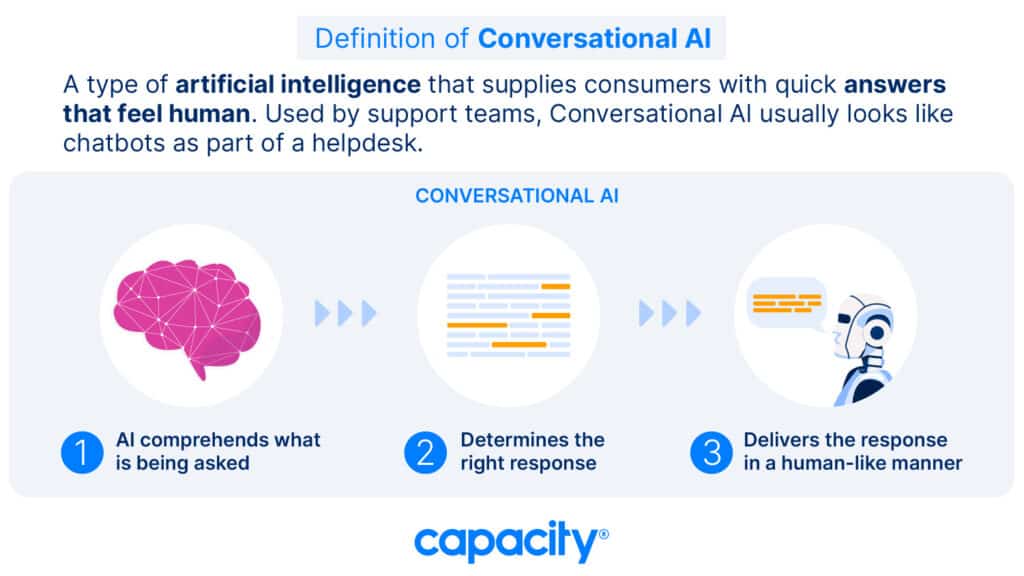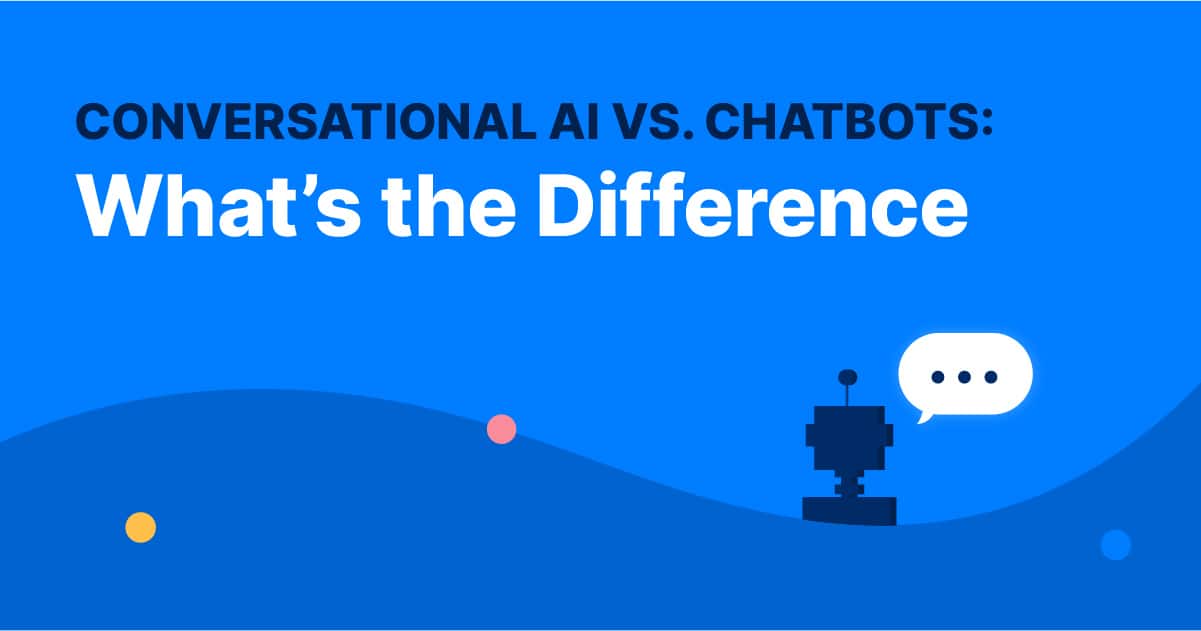Make sure to distinguish chatbots and conversational AI; although they are regularly used interchangeably, there is a vast difference between them. Take time to recognize the distinctions before deciding which technology will be most beneficial for your customer service experience.
Companies today are continually striving to enhance the customer experience while simultaneously cutting operational costs, and they’ve identified that chatbots and conversational AI can help them do just that. According to industry reports, by 2024, we’ll see the market worth $9.4 million in global chatbot applications – proof enough of its immense potential!
What separates chatbots and conversational AI?
Chatbots are the perfect choice for companies that must provide superior customer experiences while saving time and resources. Unlike ordinary conversations, these programs use predetermined conversation flows or sophisticated AI technology like natural language processing (NLP) to understand user queries and instantly reply with relevant, real-time answers!
Conversational AI is a broad category of Artificial Intelligence solutions that use data, machine learning, and NLP to provide vocal and text inputs. This technology allows chatbots or virtual assistants such as Siri or Amazon Alexa to engage in conversations with humans just like us–recognizing our words, responding naturally to questions, and experiencing an unbroken flow throughout the exchange.
Okay, so what is a chatbot?
Depending on their functioning capabilities, chatbots are typically categorized as either AI-powered or rule-based.

AI-Powered Chatbots
Automated bots serve as a modern-day equivalent to automated phone menus, providing customers with the answers they seek by navigating through an array of options. By utilizing this cutting-edge technology, companies and customer service reps can save time and energy while efficiently addressing basic queries from their consumers.
Rule-based chatbots
Also known as decision-tree, menu-based, script-driven, button-activated, or standard bots, these are the most basic type of bots. They converse through preprogrammed protocols (if customer says “A,” respond with “B”). Conversations are akin to a decision tree where customers can choose depending on their needs. Such rule-based conversations create an effortless user experience and facilitate swift resolutions for queries.
With the help of chatbots, businesses can foster a more personalized customer service experience. Both AI-driven and rule-based bots provide customers with an accessible way to self-serve.
The impact of chatbots and conversational AI
It is estimated that customer service teams handling 10,000 support requests every month can save more than 120 hours per month by using chatbots. Using that same math, teams with 50,000 support requests would save more than 1,000 hours, and support teams with 100,000 support requests would save more than 2,500 hours per month. That’s impressive.
That’s why chatbots are so popular – they improve customer experience and reduce company operational costs. As businesses get more and more support requests, chatbots have and will become an even more invaluable tool for customer service.
Whether you use rule-based chatbots or some conversational AI, automated messaging technology goes a long way in helping brands offer quick customer support. Maryville University, Chargebee, Bank of America, and several other major companies are leading the way in using this tech to resolve customer requests efficiently and effectively.
What is conversational AI?
Conversational AI can comprehend and react to both vocal and written commands. This technology has been used in customer service, enabling buyers to interact with a bot through messaging channels or voice assistants on the phone like they would when speaking with another human being. The success of this interaction relies on an extensive set of training data that allows deep learning algorithms to identify user intent more easily and understand natural language better than ever before.

How chatbots relate to conversational AI
Chatbots are conversational AI, though not all fall within this category. Rule-based chatbots rely on keywords and language identifiers to elicit particular responses from the user – however, these do not depend upon cognitive computing technologies.
Conversational AI chatbots are excellent at replicating human interactions, improving user experience, and increasing agent satisfaction. These bots can handle simple inquiries, allowing live agents to focus on more complex customer issues that require a human touch. This reduces wait times and will enable agents to spend less time on repetitive questions.
5 differences between chatbots and AI
- Rule-based chatbots follow set protocols, while AI can understand human language. What does this mean? AI can learn from customer input, while rule-based chatbots only respond to exact keywords and language identifiers.
- Chatbots use keywords and language identifiers to solicit predetermined responses from the user. Yet, Artificial Intelligence is a much more robust system as it can comprehend vocal input and written commands. AI’s ability to recognize user intent, combined with its capacity for understanding natural human languages, makes it far superior to that Chatbot systems.
- Chatbots provide users with pre-defined answers, whereas AI can generate responses based on user input, meaning users can get more tailored answers and solutions. Chatbots rely on keywords, while AI can ‘think’ holistically.
- Chatbots are limited in their ability complex queries, whereas AI can use machine learning and deep learning algorithms to understand user intent better.
- Chatbots can handle simple customer inquiries, while AI is ideal for more sophisticated customer queries. Chatbots and conversational AI are the perfect solutions to reduce customer service.

The Future of Chatbots vs. Conversational AI
Conversational AI chatbots have revolutionized customer service, allowing businesses to interact with their customers more quickly and efficiently than ever before. Chatbot technology is rapidly becoming the preferred way for brands to engage with their audiences, offering timely responses and fast resolution times.
Compared to traditional chatbots, conversational AI chatbots offer much higher levels of engagement and accuracy in understanding human language. The ability of these bots to recognize user intent and understand natural languages makes them far superior when it comes to providing personalized customer support experiences. In addition, AI-enabled bots are easily scalable since they learn from interactions, meaning they can grow and improve with each conversation had.
As businesses become increasingly concerned about customer experience, conversational AI will continue to become more popular and essential. As AI technology is further integrated into customer service processes, brands can provide their customers with better experiences faster and more efficiently.
Ultimately, both Chatbots and Conversational AI have the potential to revolutionize customer service as we know it. Businesses can choose from various technologies that best serve their individual needs depending on the complexity of the queries asked. With new advancements in AI technology every day, one thing is sure: chatbots built using conversational AI are here to stay.
Ready to see AI chatbot technology in action? Try Capacity for free today.





